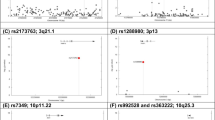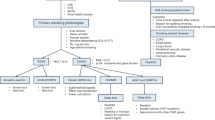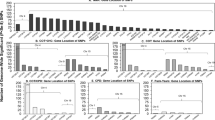Abstract
This study evaluated association between common and rare sequence variants in 10 nicotinic acetylcholine receptor subunit genes and the severity of nausea 21 days after initiating the standard, Food and Drug Administration-approved varenicline regimen for smoking cessation. A total of 397 participants from a randomized clinical effectiveness trial with complete clinical and DNA resequencing data were included in the analysis (mean age=49.2 years; 68.0% female). Evidence for significant association between common sequence variants in CHRNB2 and nausea severity was obtained after adjusting for age, gender and correlated tests (all PACT<0.05). Individuals with the minor allele of CHRNB2 variants experienced less nausea than did those without the minor allele, consistent with previously reported findings for CHRNB2 and the occurrence of nausea and dizziness as a consequence of first smoking attempt in adolescents, and with the known neurophysiology of nausea. As nausea is the most common reason for discontinuance of varenicline, further pharmacogenetic investigations are warranted.
This is a preview of subscription content, access via your institution
Access options
Subscribe to this journal
Receive 6 print issues and online access
$259.00 per year
only $43.17 per issue
Buy this article
- Purchase on Springer Link
- Instant access to full article PDF
Prices may be subject to local taxes which are calculated during checkout
Similar content being viewed by others
References
Coe JW, Brooks PR, Vetelino MG, Wirtz MC, Arnold EP, Huang J et al. Varenicline: an alpha4beta2 nicotinic receptor partial agonist for smoking cessation. J Med Chem 2005; 48: 3474–3477.
Rollema H, Chambers LK, Coe JW, Glowa J, Hurst RS, Lebel LA et al. Pharmacological profile of the alpha4beta2 nicotinic acetylcholine receptor partial agonist varenicline, an effective smoking cessation aid. Neuropharmacology 2007; 52: 985–994.
Cahill K, Stead LF, Lancaster T . Nicotine receptor partial agonists for smoking cessation. Cochrane Database Syst Rev 2008. Issue No. 3. Article No. CD006103.
Mihalak KB, Carroll FI, Luetje CW . Varenicline is a partial agonist at alpha4beta2 and a full agonist at alpha7 neuronal nicotinic receptors. Mol Pharmacol 2006; 70: 801–805.
Cahill K, Stead L, Lancaster T . A preliminary benefit-risk assessment of varenicline in smoking cessation. Drug Saf 2009; 32: 119–135.
Kasliwal R, Wilton LV, Shakir SA . Safety and drug utilization profile of varenicline as used in general practice in England: interim results from a prescription-event monitoring study. Drug Saf 2009; 32: 499–507.
Rigotti NA, Pipe AL, Benowitz NL, Arteaga C, Garza D, Tonstad S . Efficacy and safety of varenicline for smoking cessation in patients with cardiovascular disease: a randomized trial. Circulation 2010; 121: 221–229.
Mandl P, Kiss JP . Role of presynaptic nicotinic acetylcholine receptors in the regulation of gastrointestinal motility. Brain Res Bull 2007; 72: 194–200.
Sanger GJ, Andrews PL . Treatment of nausea and vomiting: gaps in our knowledge. Auton Neurosci 2006; 129: 3–16.
Ehringer MA, Clegg HV, Collins AC, Corley RP, Crowley T, Hewitt JK et al. Association of the neuronal nicotinic receptor beta2 subunit gene (CHRNB2) with subjective responses to alcohol and nicotine. Am J Med Genet B Neuropsychiatr Genet 2007; 144B: 596–604.
Conti DV, Lee W, Li D, Liu J, Van Den Berg D, Thomas PD et al. Nicotinic acetylcholine receptor beta2 subunit gene implicated in a systems-based candidate gene study of smoking cessation. Hum Mol Genet 2008; 17: 2834–2848.
Halperin AC, McAfee TA, Jack LM, Catz SL, McClure JB, Deprey TM et al. Impact of symptoms experienced by varenicline users on tobacco treatment in a real world setting. J Subst Abuse Treat 2009; 36: 428–434.
Wessel J, McDonald SM, Hinds DA, Stokowski RP, Javitz HS, Kennemer M et al. Resequencing of nicotinic acetylcholine receptor genes and association of common and rare variants with the Fagerström test for nicotine dependence. Neuropsychopharmacology 2010; 35: 2392–2402.
McClure JB, Swan GE, Catz SL, Jack L, Javitz H, McAfee T et al. Smoking outcome by psychiatric history after behavioral and varenicline treatment. J Subst Abuse Treat 2010; 38: 394–402.
McClure JB, Swan GE, Jack L, Catz SL, Zbikowski SM, McAfee TA et al. Mood, side-effects and smoking outcomes among persons with and without probable lifetime depression taking varenicline. J Gen Intern Med 2009; 24: 563–569.
Swan GE, McClure JB, Jack LM, Zbikowski SM, Javitz HS, Catz SL et al. Behavioral counseling and varenicline treatment for smoking cessation. Am J Prev Med 2010; 38: 482–490.
Fiore MC, Jaén CR, Baker TB, Bailey WC, Benowitz NL, Curry SJ et al. (2008) Treating tobacco use and dependence: 2008 update. In: Clinical Practice Guideline. US Department of Health and Human Services. Public Health Service: Clincial Practice Guideline: Rockville, MD.
Heatherton TF, Kozlowski LT, Frecker RC, Fagerström KO . The Fagerström test for nicotine dependence: a revision of the Fagerström Tolerance Questionnaire. Br J Addict 1991; 86: 1119–1127.
Nishita DM, Jack LM, McElroy M, McClure JB, Richards J, Swan GE et al. Clinical trial participant characteristics and saliva and DNA metrics. BMC Med Res Methodol 2009; 9: 71.
Margulies M, Egholm M, Altman WE, Attiya S, Bader JS, Bemben LA et al. Genome sequencing in microfabricated high-density picolitre reactors. Nature 2005; 437: 376–380.
Sanger F, Nicklen S, Coulson AR . DNA sequencing with chain-terminating inhibitors. Proc Natl Acad Sci USA 1977; 74: 5463–5467.
Conneely KN, Boehnke M . So many correlated tests, so little time! Rapid adjustment of P values for multiple correlated tests. Am J Hum Genet 2007; 81: p1158–1168.
Madsen BE, Browning SR . A groupwise association test for rare mutations using a weighted sum statistic. PLoS Genet 2009; 5: e1000384.
Kryukov GV, Shpunt A, Stamatoyannopoulos JA, Sunyaev SR . Power of deep, all-exon resequencing for discovery of human trait genes. Proc Natl Acad Sci USA 2009; 106: 3871–3876.
Nievergelt CM, Libiger O, Schork NJ . Generalized analysis of molecular variance. PLoS Genet 2007; 3: e51.
Schork NJ, Wessel J, Malo N . DNA sequence-based phenotypic association analysis. Adv Genet 2008; 60: 195–217.
Wessel J, Schork NJ . Generalized genomic distance-based regression methodology for multilocus association analysis. Am J Hum Genet 2006; 79: 792–806.
Barrett JC, Fry B, Maller J, Daly MJ . Haploview: analysis and visualization of LD and haplotype maps. Bioinformatics 2005; 21: 263–265.
Frazer KA, Ballinger DG, Cox DR, Hinds DA, Stuve LL, Gibbs RA et al. A second generation human haplotype map of over 3.1 million SNPs. Nature 2007; 449: 851–861.
Ehringer MA, McQueen MB, Hoft NR, Saccone NL, Stitzel JA, Wang JC et al. Association of CHRN genes with ‘dizziness’ to tobacco. Am J Med Genet B Neuropsychiatr Genet 2010; 153B: 600–609.
Hoft NR, Stitzel JA, Hutchison KE, Ehringer MA . CHRNB2 promoter region: association with subjective effects to nicotine and gene expression differences. Genes Brain Behav 2010; 10: 176–185.
Perkins KA, Lerman C, Mercincavage M, Fonte CA, Briski JL . Nicotinic acetylcholine receptor beta2 subunit (CHRNB2) gene and short-term ability to quit smoking in response to nicotine patch. Cancer Epidemiol Biomarkers Prev 2009; 18: 2608–2612.
Etter JF, Hoda JC, Perroud N, Munafo M, Buresi C, Duret C et al. Association of genes coding for the alpha-4, alpha-5, beta-2 and beta-3 subunits of nicotinic receptors with cigarette smoking and nicotine dependence. Addict Behav 2009; 34: 772–775.
Feng Y, Niu T, Xing H, Xu X, Chen C, Peng S et al. A common haplotype of the nicotine acetylcholine receptor alpha 4 subunit gene is associated with vulnerability to nicotine addiction in men. Am J Hum Genet 2004; 75: 112–121.
Li MD, Beuten J, Ma JZ, Payne TJ, Lou XY, Garcia V et al. Ethnic- and gender-specific association of the nicotinic acetylcholine receptor alpha4 subunit gene (CHRNA4) with nicotine dependence. Hum Mol Genet 2005; 14: 1211–1219.
Weiss RB, Baker TB, Cannon DS, von Niederhausern A, Dunn DM, Matsunami N et al. A candidate gene approach identifies the CHRNA5-A3-B4 region as a risk factor for age-dependent nicotine addiction. PLoS Genet 2008; 4: e1000125.
Bergen AW, Conti DV, Van Den Berg D, Lee W, Liu J, Li D et al. Dopamine genes and nicotine dependence in treatment-seeking and community smokers. Neuropsychopharmacology 2009; 34: 2252–2264.
Lueders KK, Hu S, McHugh L, Myakishev MV, Sirota LA, Hamer DH . Genetic and functional analysis of single nucleotide polymorphisms in the beta2-neuronal nicotinic acetylcholine receptor gene (CHRNB2). Nicotine Tob Res 2002; 4: 115–125.
Silverman MA, Neale MC, Sullivan PF, Harris-Kerr C, Wormley B, Sadek H et al. Haplotypes of four novel single nucleotide polymorphisms in the nicotinic acetylcholine receptor beta2-subunit (CHRNB2) gene show no association with smoking initiation or nicotine dependence. Am J Med Genet 2000; 96: 646–653.
Andrews PL, Horn CC . Signals for nausea and emesis: implications for models of upper gastrointestinal diseases. Auton Neurosci 2006; 125: 100–115.
Shoaib M, Gommans J, Morley A, Stolerman IP, Grailhe R, Changeux JP . The role of nicotinic receptor beta-2 subunits in nicotine discrimination and conditioned taste aversion. Neuropharmacology 2002; 42: 530–539.
Salminen O, Murphy KL, McIntosh JM, Drago J, Marks MJ, Collins AC et al. Subunit composition and pharmacology of two classes of striatal presynaptic nicotinic acetylcholine receptors mediating dopamine release in mice. Mol Pharmacol 2004; 65: 1526–1535.
Stowe RL, Ives NJ, Clarke C, van Hilten J, Ferreira J, Hawker RJ et al. Dopamine agonist therapy in early Parkinson's disease. Cochrane Database Syst Rev 2008. Issue No. 2. Article No. CD006564.
Rowbotham MC, Duan WR, Thomas J, Nothaft W, Backonja MM . A randomized, double-blind, placebo-controlled trial evaluating the efficacy and safety of ABT-594 in patients with diabetic peripheral neuropathic pain. Pain 2009; 146: 245–252.
DiFranza JR, Savageau JA, Fletcher K, Ockene JK, Rigotti NA, McNeill AD et al. Recollections and repercussions of the first inhaled cigarette. Addict Behav 2004; 29: 261–272.
Pomerleau CS, Pomerleau OF, Namenek RJ, Marks JL . Initial exposure to nicotine in college-age women smokers and never-smokers: a replication and extension. J Addict Dis 1999; 18: 13–19.
Pomerleau OF, Pomerleau CS, Namenek RJ . Early experiences with tobacco among women smokers, ex-smokers, and never-smokers. Addiction 1998; 93: 595–599.
Toll BA, McKee SA, Martin DJ, Jatlow P, O’Malley SS . Factor structure and validity of the Medication Adherence Questionnaire (MAQ) with cigarette smokers trying to quit. Nicotine Tob Res 2007; 9: 597–605.
Hughes JR . Effects of abstinence from tobacco: valid symptoms and time course. Nicotine Tob Res 2007; 9: 315–327.
Mills EJ, Wu P, Lockhart I, Wilson K, Ebbert JO . Adverse events associated with nicotine replacement therapy (NRT) for smoking cessation. A systematic review and meta-analysis of one hundred and twenty studies involving 177,390 individuals. Tob Induc Dis 2010; 8: 8.
Hughes JR, Stead LF, Lancaster T . Antidepressants for smoking cessation. Cochrane Database Syst Rev 2007. Issue No. 1. Article No. CD000031.
Acknowledgements
We thank the participants of the COMPASS smoking cessation clinical trial (CA071358, PI Gary Swan). We also appreciate the efforts of the quit coaches and the research staff of Free & Clear, the staff of the Group Health Research Institute's Survey Research Program, and Mary McElroy, Gaye Courtney, Peggy Giacalone and Trish McLeod of SRI International, whose contributions were essential to provide the data for this analysis. We also acknowledge the consultative assistance of Dr Ray Niaura, Dr Caryn Lerman and Dr Neal Benowitz, who served on the data and safety monitoring board of the study. Dr Lerman and Dr Tyndale read and commented on an earlier version of this article. This study was supported by CA071358 (a grant from NCI), U01DA020830 (a grant from NIDA, NCI, NIGMS and NHGRI), the Material Transfer and Research Agreement between SRI International and Perlegen Sciences, and the National Cancer Institute (grant # R01CA071358). This study is registered at Clinicaltrials.gov (NCT00301145).
Author information
Authors and Affiliations
Corresponding author
Ethics declarations
Competing interests
Varenicline and the nominal support for recruiting participants was provided by Pfizer. Neither entity had any role in the study design, collection, analysis and interpretation of data, in the writing of the report or in the decision to submit the report for publication. Swan, Javitz, Jack, Wessel, Michel, Hinds, Stokowski, McClure, Catz, Richards, Zbikowski, Deprey, McAfee, Conti and Bergen declare that all financial and material support for this work was provided by their primary employer. Javitz, Jack, Wessel, Michel, Hinds, Stokowski, McClure, Catz, Richards, Zbikowski, Deprey, McAfee and Bergen declare that, except for income provided from their primary employer, no other financial support or compensation has been received from any individual or corporate entity over the past 3 years for research or professional services nor are there personal financial holdings that could be perceived as constituting a potential conflict of interest. Dr Swan received financial support from Pfizer to attend a 1-day advisory meeting in 2008. Dr Conti was a paid consultant for Pfizer in 2008. Dr Wessel is currently employed by Indiana University, Dr Hinds is currently employed by 23 and Me, Dr Stokowski is currently employed by Tandem Diagnostics and Dr McAfee is currently employed by the Centers for Disease Control and Prevention.
Rights and permissions
About this article
Cite this article
Swan, G., Javitz, H., Jack, L. et al. Varenicline for smoking cessation: nausea severity and variation in nicotinic receptor genes. Pharmacogenomics J 12, 349–358 (2012). https://doi.org/10.1038/tpj.2011.19
Received:
Revised:
Accepted:
Published:
Issue Date:
DOI: https://doi.org/10.1038/tpj.2011.19



